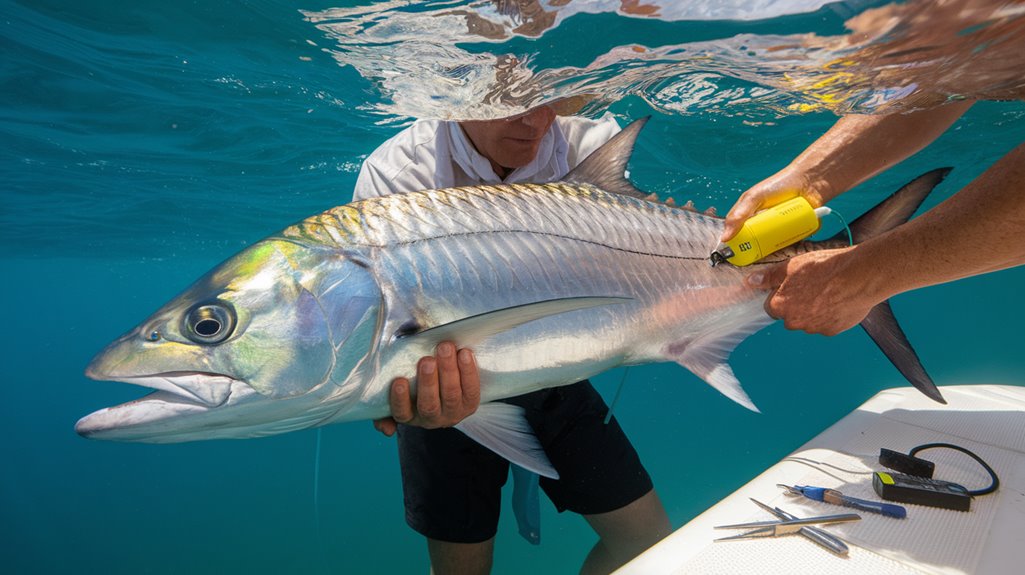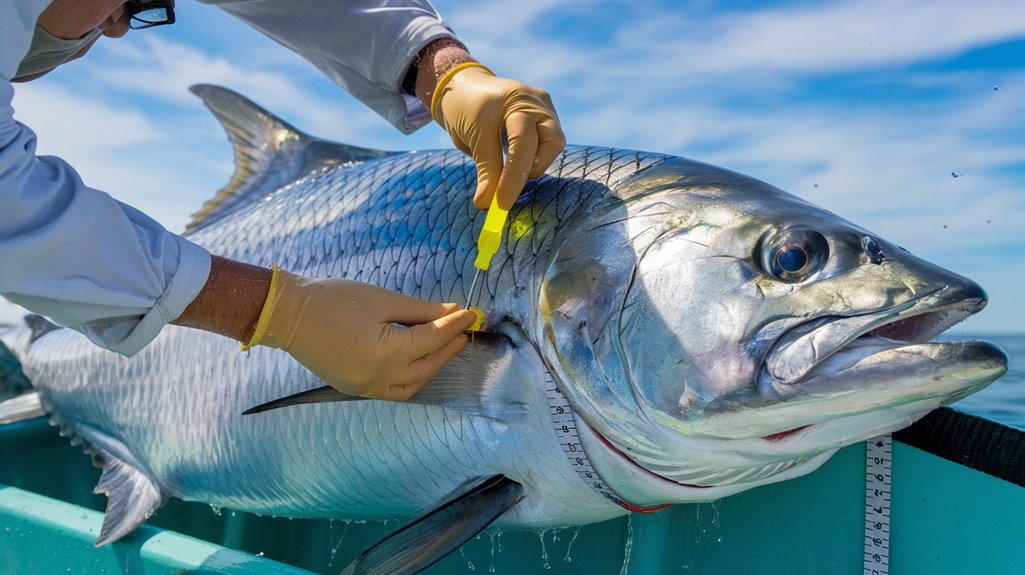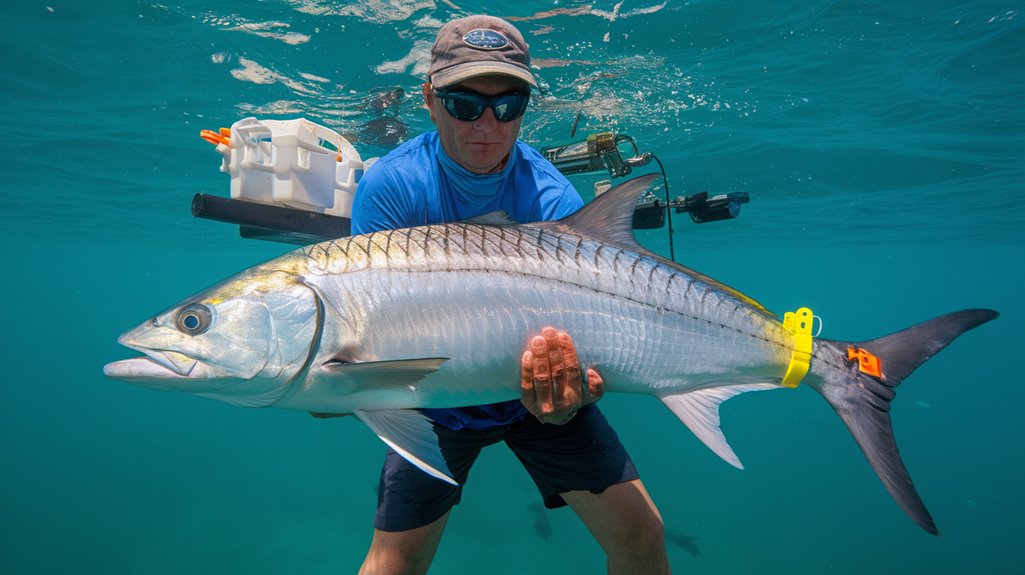You'll find that tracking tarpon requires a sophisticated blend of technological tools and methodological precision. From satellite tags that beam real-time location data to acoustic transmitters that monitor local movements, each technique reveals distinct aspects of tarpon behavior. Modern tracking methods have transformed our understanding of these ancient fish, showing complex migration patterns and habitat preferences that weren't previously known. Let's examine the specific approaches that make this research possible.
- Key Takeaways
- Understanding Tarpon Biology and Behavior
- Types of Tags Used in Tarpon Research
- External Tag Attachment Methods
- Telemetry Equipment and Technology
- Data Collection and Analysis Protocols
- Movement Pattern Assessment
- Environmental Impact Considerations
- Research Applications and Management
- Frequently Asked Questions
- Conclusion
Key Takeaways
- SPOT satellite tags provide real-time location tracking of larger tarpon, transmitting data about position, depth, and temperature.
- Acoustic tags surgically implanted in tarpon emit sound pulses detected by underwater receivers for continuous localized monitoring.
- Researchers use movement-based kernel density estimation and correlated random walk models to analyze tarpon migration patterns.
- External tags must be carefully positioned using lip grip or tailer methods to minimize interference with swimming performance.
- PIT tags offer individual monitoring capabilities while minimizing physical impact on smaller or younger tarpon specimens.
Understanding Tarpon Biology and Behavior

The majestic Atlantic tarpon stands as one of the ocean's most remarkable game fish, reaching dimensions of up to 8 feet and weights of 280 pounds. Understanding their biology and behavior is vital for effective tagging methods and tracking fish in their natural environment.
Through acoustic telemetry and fisheries science, you'll find that tarpon populations exhibit complex fish movement patterns, particularly in the northern Gulf of Mexico. Their habitat use includes distinctive east-west migrations, with concentrated activity around the Mississippi River Delta. You'll notice they're particularly drawn to Louisiana's waters during fall, where enriched riverine discharge creates prime foraging conditions. While spawning sites remain elusive, larvae distribution suggests breeding occurs near Pass a Loutre's offshore waters, making this knowledge essential for conservation and studying tarpon populations.
Types of Tags Used in Tarpon Research
You'll find that researchers primarily employ two distinct tracking technologies for tarpon: SPOT tags that transmit satellite-based location data, and acoustic tags that communicate with underwater receivers. While SPOT tags are externally mounted on larger tarpon for broader geographic tracking, acoustic tags can be surgically implanted in tarpon as small as five pounds for localized monitoring. The choice between these tagging methods depends on research objectives, with satellite tags offering wide-ranging migration data and acoustic tags providing detailed movement patterns within specific areas.
Satellite vs. Acoustic Tags
When tracking tarpon movement patterns, researchers primarily rely on two distinct tagging technologies: satellite tags and acoustic tags. You'll find satellite tags externally attached to larger tarpon, transmitting location data when they surface, enabling researchers to track their extensive migrations up to Chesapeake Bay. In contrast, acoustic tags are surgically implanted and emit sound pulses detected by underwater receivers, offering precise tracking within specific habitats.
While satellite tags are more expensive and limited to larger fish, acoustic tags provide flexibility in studying smaller tarpon. The combined use of these technologies delivers thorough data about tarpon movements across different scales. This dual approach to tracking enhances our understanding of tarpon spatial dynamics, ultimately supporting more effective conservation strategies for protecting this species throughout its range.
Tag Attachment Methods
Modern tarpon research employs three primary tag attachment methods, each serving distinct tracking purposes. You'll find SPOT tags externally mounted for satellite tracking, while acoustic telemetry uses surgically implanted tags for continuous monitoring. External visible tags round out the toolkit for basic identification and movement studies.
| Tag Type | Application Method |
|---|---|
| SPOT Tags | External mount with lip grip/tailer |
| Acoustic Tags | Surgical implantation |
| Visual Tags | External attachment |
These methods allow researchers to track fish behavior and habitat use across different size ranges. While SPOT tags work well for larger tarpon in the Gulf of Mexico, acoustic telemetry proves effective for tracking smaller fish weighing as little as five pounds. Your choice of tagging method depends on research objectives and the target fish size.
External Tag Attachment Methods

While external tag attachment methods for tarpon have evolved considerably, spaghetti tags remain one of the most cost-effective tracking solutions. When you're working with tarpon, you'll need to carefully consider tag attachment techniques that use either steel wire or nylon filaments, ensuring the tag sits snugly against the fish's body to prevent entanglement and minimize drag.
Recent tagging studies have shown that advanced dart attachment methods can notably improve tag retention while reducing impacts on swimming performance. You'll want to pay special attention to placement, as critical swimming speed measurements indicate that poorly positioned external tags can impair a tarpon's natural movement. While retention rates vary across marine species, you can achieve ideal results by selecting attachment points that don't interfere with the tarpon's muscular function during their characteristic rolling behavior.
Telemetry Equipment and Technology
Beyond physical tags, sophisticated telemetry systems now enable thorough tracking of tarpon behavior and movement patterns. You'll find three primary technologies employed in telemetry studies: satellite tags that transmit location, depth, and temperature data; acoustic tags that emit sound pulses detected by underwater receivers; and PIT tags that monitor individual movements through specialized readers.
Satellite tags, while costly, provide extensive data for Fisheries Management, tracking tagged individuals across vast distances. Acoustic tags offer real-time monitoring capabilities, helping researchers understand habitat use and daily movement patterns. Recent advances in telemetry technology have introduced smaller tags with extended battery life, allowing scientists to track younger tarpon and conduct longer studies. This improved equipment delivers more detailed insights into fish movement and behavior across diverse marine environments.
Data Collection and Analysis Protocols

You'll need to apply rigorous data filtration methods, including Kalman filters to Doppler-derived positions, to guarantee your tarpon tracking data excludes erroneous land-based estimates and unrealistic swimming speeds. Your movement pattern analysis should incorporate both movement-based kernel density estimation for core habitat visualization and correlated random walk state-space modeling to evaluate behavioral indices. After processing data from 23 SPOT-tagged tarpon between 2018-2019, you can generate detailed spatial distributions and movement corridors that reveal migration patterns and habitat preferences.
Filtering Raw Location Data
To guarantee reliable analysis of tarpon movements, researchers implemented thorough data filtering protocols for the raw location data obtained from tagged specimens. The process included applying Kalman filters to Doppler-derived position estimates, which enhanced the accuracy of location data. You'll find that the filtering methods retained only specific location classes, ensuring dataset reliability.
The researchers eliminated land-based location estimates and data showing unrealistic swimming speeds to improve data quality. By keeping only high-quality locations, they could effectively visualize core habitat use and movement patterns. This rigorous filtration protocol proved essential for accurately estimating movement persistence and space use of tagged tarpon in the northern Gulf of Mexico, providing a clear picture of their behavioral patterns.
Movement Pattern Calculations
After establishing clean datasets through rigorous filtering, researchers implemented thorough movement pattern calculations to analyze tarpon behavior. They utilized Kalman filters and movement-based kernel density estimation to track tagged fish swims within range of monitoring stations across the Gulf of Mexico. The data collected revealed consistent east-west movement patterns, particularly around the Mississippi River Delta.
You'll find that correlated random walk state-space models helped determine behavioral indices for the fish population, providing vital insights into habitat utilization. The analysis of 23 SPOT-tagged tarpon from 2018-2019 demonstrated significant movement and habitat preferences in shallow waters, especially near Pass a Loutre. Using advanced acoustics and positioning systems, researchers mapped core habitat zones, giving you an all-encompassing understanding of how this fish species navigates its environment.
Movement Pattern Assessment
Movement patterns of Atlantic tarpon across the northern Gulf of Mexico reveal distinct spatial behaviors and habitat preferences. Using satellite telemetry and acoustic tracking, you'll find that tagged tarpon demonstrate consistent east-west movements, with concentrated activity around the Mississippi River Delta. Analysis of 23 fish species showed varying movement persistence, highlighting Alabama and Mississippi as high-persistence areas.
- Core habitat use clusters in shallow waters near Pass a Loutre State Wildlife Management Area
- Movement-based kernel density estimations reveal critical Louisiana habitats with low persistence
- Correlated random walk models indicate limited spawning in Mississippi waters, with fish primarily using the area for transit
The fisheries data suggests tarpon's prevalence in Louisiana during fall months is driven by foraging opportunities, while their movement patterns reflect strategic habitat selection across the northern Gulf region.
Environmental Impact Considerations
The environmental impact of tarpon tagging requires careful consideration of both direct and indirect effects on the species. When you're using biotelemetry methods, it's vital to understand that both acoustic tagging and satellite tags can affect the fish's natural behavior. You'll need to minimize air exposure during the tagging process to prevent tissue damage and reduce post-release mortality rates.
Environmental factors like water temperature and salinity will influence your tag retention success, while the physical presence of tags can create drag that impacts the fish's swimming performance. You'll find that careful site selection and proper handling techniques are essential to reduce these impacts. By implementing minimally invasive tagging methods and considering habitat complexity, you'll help guarantee that your research activities don't compromise the tarpon's ability to feed, migrate, or evade predators.
Research Applications and Management
Research applications of tarpon tagging extend far beyond simple monitoring, generating valuable insights that shape conservation policies and management strategies. You'll find that satellite tags provide real-time data on tarpon movement patterns, while conservation partners and citizen scientists contribute to genetic mark-recapture studies through tissue sampling. Tagging studies have revealed Louisiana's Mississippi River Delta as an essential habitat, influencing regional management decisions.
- Fisheries science benefits from long-term tracking data, showing tarpon migrations extending to Chesapeake Bay
- Fish health assessments through tagging help determine the effectiveness of catch-and-release practices
- Fish tagging programs support evidence-based regulatory decisions by documenting habitat use and spawning areas
These collaborative efforts between researchers and citizen scientists continue strengthening tarpon conservation across their range.
Frequently Asked Questions
What Are the Methods of Fish Tagging?
You'll find external methods like spaghetti tags and Floy tags, plus internal options including acoustic transmitters. For larger fish, satellite tags offer advanced tracking by transmitting data through satellites.
What Are the Different Types of Fish Telemetry?
You'll find three main telemetry types: acoustic telemetry using underwater sound signals, satellite telemetry for surface-transmitted data, and GPS telemetry offering precise location tracking across aquatic environments.
Why Do People Tag Fish?
You'll tag fish to monitor their migrations, study population dynamics, track growth rates, assess habitat usage, and gather essential data for developing effective conservation strategies and fisheries management policies.
What Is Tarpon Related To?
You'll find tarpon closely related to bonefish and permit within the Megalopidae family, while sharing ancestral ties with tenpounders and prehistoric bony fish in the order Elopiformes.
Conclusion
You've now gained insights into cutting-edge tarpon tracking methodologies that integrate SPOT and acoustic telemetry. Through data-driven analysis of movement patterns and habitat utilization, you'll better understand Megalops atlanticus behavior across diverse marine environments. These technological applications enable you to contribute to evidence-based conservation strategies while minimizing environmental impact. Your research efforts support essential management decisions for this species' long-term survival.
